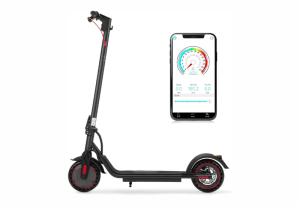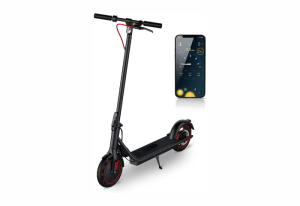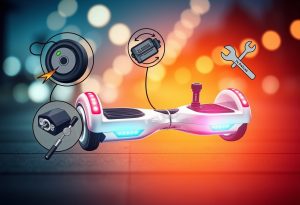Perseverance is key when it comes to mastering the art of balancing on a hoverboard. With the rise in popularity of hoverboards, many individuals have sought to perfect their skills in riding and balancing on these futuristic devices. In this blog post, we will delve into the techniques and strategies that can help you become a pro at effortlessly gliding on your hoverboard. From understanding the physics of balance to honing your body control, we will explore various aspects that contribute to achieving a stable and confident stance on a hoverboard. So, if you’re ready to elevate your hoverboard game, read on to discover the secrets to becoming a master of balance.
Table of Contents
ToggleUnderstanding Hoverboard Mechanics
Before mastering the art of balancing on a hoverboard, it’s important to understand the mechanics behind how these innovative devices work. By delving into the intricacies of hoverboard mechanics, you can gain a better understanding of how to maintain balance and control while riding.
How Hoverboards Work
Hoverboards, also known as self-balancing scooters, operate through a combination of advanced gyroscopic sensors and motorized wheels. These sensors detect changes in the rider’s center of gravity and communicate this data to the onboard microprocessors, which then adjust the speed and direction of the wheels to maintain balance. This seamless interaction between sensors and microprocessors allows riders to control the hoverboard simply by shifting their weight.
Key Components for Balance
The key components for balance on a hoverboard include the gyroscopic sensors, microprocessors, and motorized wheels. The gyroscopic sensors constantly monitor the rider’s position and make split-second adjustments to the motorized wheels, while the microprocessors act as the brains of the operation, interpreting the sensor data and controlling the movement of the wheels. The motorized wheels then respond to the commands from the microprocessors, providing the necessary propulsion and stability for the rider.
Understanding how these key components work in harmony is essential for mastering the art of balancing on a hoverboard. By learning to work with the sensors, microprocessors, and wheels, riders can achieve a greater level of control and finesse on their hoverboards, ultimately enhancing their overall riding experience.
Preparing to Ride
Obviously, before you can even attempt to ride a hoverboard, you need to make sure you are properly prepared. This includes ensuring you have the right safety gear, understanding the precautions to take, and knowing how to position yourself on the hoverboard.
Safety Gear and Precautions
Ride with confidence by wearing the necessary safety gear such as a helmet, elbow pads, and knee pads. These will protect you from potential falls and injuries. Additionally, make sure to carefully read the user manual that comes with your hoverboard to understand the proper safety precautions and how to operate the device.
Standing and Positioning on the Hoverboard
One of the most important aspects of mastering the art of balancing on a hoverboard is learning how to stand and position yourself on the board correctly. This involves keeping your feet shoulder-width apart and making sure your weight is evenly distributed.
The proper stance on a hoverboard is essential for maintaining balance and control. The position of your feet and how you distribute your weight can greatly impact your ability to ride the hoverboard smoothly and effortlessly.
Techniques for Mastering Balance
For beginners, mastering the art of balancing on a hoverboard can seem like a daunting task. However, with the right techniques and practice, achieving a stable and confident posture on a hoverboard is definitely within reach.
Basic Movement and Control
To master the art of balancing on a hoverboard, it is essential to first focus on the basic movement and control. Begin by standing with your feet shoulder-width apart and distributing your weight evenly on both feet. This will help you maintain stability as you start moving forward or backward. Practice shifting your weight gently to control the speed and direction of the hoverboard. Remember to keep your knees slightly bent to absorb any sudden movements and maintain balance.
Turning and Advanced Maneuvers
Control and coordination are key when it comes to turning and mastering advanced maneuvers on a hoverboard. Here are some techniques to help you achieve greater control and confidence:
- Control Speed: Gradually lean forward to accelerate and lean backward to decelerate.
- Foot Placement: Positioning your feet closer together can help in making sharper turns.
- Body Movement: Shift your body weight in the direction you want to turn to initiate smooth and controlled movement.
The ability to execute turning and advanced maneuvers on a hoverboard requires practice and patience. By honing these techniques, you will be able to navigate through different obstacles and terrain with confidence and grace.
Practice Regimens and Tips
To master the art of balancing on a hoverboard, consistent practice is key. Here are some practice regimens and tips to help you improve your skills:
- Start by practicing in a wide, open space free from obstacles
- Keep your knees slightly bent and your weight evenly distributed
- Focus on maintaining a straight posture and keeping your eyes forward
- Engage your core muscles to help with balance
- Remember to remain patient and persistent, as learning to balance on a hoverboard takes time and dedication
After mastering the basic techniques, you can start incorporating different drills to further enhance your stability and control on the hoverboard.
Drills for Enhancing Stability
On your hoverboard, try practicing stationary balance by holding onto a sturdy support and slowly lifting one foot off the ground at a time. Once you feel comfortable with this, you can then move on to practicing controlled movements such as figure eights and tight turns to improve your agility and balance. These drills will help you develop a strong foundation for mastering the art of balancing on a hoverboard.
Common Mistakes and How to Avoid Them
Any time you are learning a new skill, it’s natural to make mistakes. Some common mistakes when balancing on a hoverboard include leaning too far forward or backward, and not keeping your eyes focused ahead. Enhancing your technique and avoiding these mistakes is crucial in becoming proficient at riding a hoverboard.
How to Master the Art of Balancing on a Hoverboard?
With these considerations in mind, mastering the art of balancing on a hoverboard will require patience, practice, and a solid understanding of the basic principles of weight distribution and control. By following the tips and techniques outlined in this guide and consistently practicing your skills, you can quickly improve your balance and confidence on a hoverboard. Remember to always prioritize safety and wear protective gear while riding, and never attempt advanced maneuvers without proper experience and training. With dedication and perseverance, you can become a proficient hoverboard rider and enjoy the thrill of effortlessly gliding through your surroundings.






